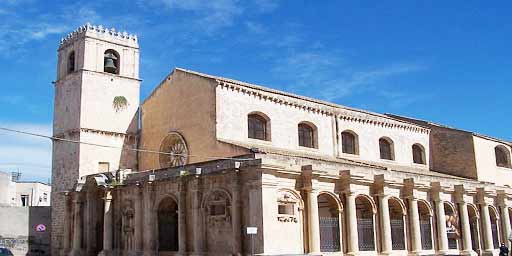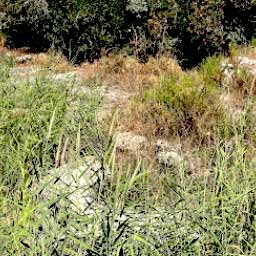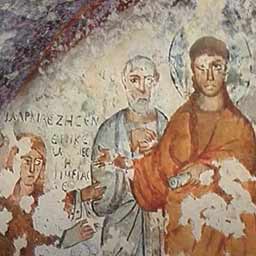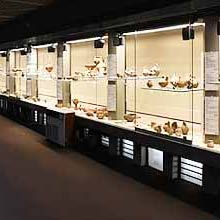Church of Santa Lucia al Sepolcro in Syracuse
The Monumental Complex of Santa Lucia "Extra Moenia" in Syracuse is one of the places most dear to the Syracusans, since, in the city that gave her birth, the Patron Saint suffered martyrdom in the year 304, becoming for all an example of virtue and courage.
The written documents, that is the ancient Papadopulo code which contains the acts of the martyrdom of the Saint, affirm that the saint was taken outside the city walls, in the place where the basilica stands today . The exact spot where she was beheaded is marked by a granite column that is located inside the presbytery of the Basilica. Subsequently the body of the martyr was placed in a tomb dug into the rock within the area of the catacombs below, thus becoming a pilgrimage destination for many faithful.
The monumental complex that the square hosts is located in the Borgata area, district born only at the end of the 19th century, and includes the Basilica of Santa Lucia al Sepolcro and the adjoining convent of the Franciscan Fathers, the octagonal Tempietto, which houses the tomb of the Saint and the Catacomb, dating back to the III, IV and V centuries and used as a place of worship also in the following centuries.
The Basilica of Santa Lucia al Sepolcro stands on the place where the Saint was martyred in the year 304 . After the peace of Constantine, the Syracusans built a church dedicated to the martyr of which nothing remains following the destruction caused by the various earthquakes and the Arab domination. The current church dates back to the religious restoration of the Norman period which is believed not to have altered the lines of the previous basilica. Over the centuries it has undergone various alterations.
The facade has a portal consisting of a large arch in the center inscribed in a lowered tympanum, considered the most evident reference to the Norman factory. The introduction or reconstruction of the central rose window, the construction of the bell tower, which was originally on two floors, and the construction of the wooden trussed roof, which came to light only in 1939, date back to a fourteenth-century makeover wanted by Philip II of Aragon. , since up until that moment it had been completely covered with barrel vaults. Along the south and west sides runs the colonnade of the portico called the "gallery before the doors of the temple", whose construction dates back to 1723, based on a project by Pompeo Picherali. On December 15, 1970, the complete collapse of the portico occurred unexpectedly and was then rebuilt with a technique called anastylosis: the collapsed blocks were put back together and in a short time the original structure was restored.
The church has a large central nave, flanked by the two smaller ones, which is part of the typical forms of Norman architecture. The construction of the large round arches and the pillars which probably contain the ancient Norman columns inside them, dates back to the arrival in the city of the reformed Franciscan Fathers in 1618.
Of considerable value is the altarpiece d 'Altar , which represents the burial of Saint Lucia, by Michelangelo Merisi, the Caravaggio .
The temple of the Sepulcher was built in the seventeenth century, based on a project by Giovanni Vermexio, in the center of the catacomb area on an ancient church dedicated to S. Agata which was then demolished. A large double flight staircase gives access to the church which consists of 4 doors, but only two, the largest, are marked by a corresponding external architecture.
Externally the church is characterized by rich capitals that mark the corners of the octagon but, the architectural decoration was extended only to the four sides which face the large square: the others, remaining invisible, never received the decorative covering.
The church houses the burial niche embellished, in the Byzantine or Norman age, by a bas-relief depicting three fantastic animals of medieval origin, the meaning of which is, according to the interpretation of various scholars , linked to the moral qualities of the Saint: the griffin is a symbol of incorruption, the dove is a symbol of purity and the lion indicates courage. The tomb also once housed the marble statue of Lucia, which miraculously exuded in 1735 and which was built by Gregorio Tedeschi in 1634. In 1912 it was decided to move the statue inside a glass case below the altar to make the burial more sober.
The catacomb of Santa Lucia al Sepolcro below the current Piazza Santa Lucia, extends to the south-west of the church and is characterized by a rather complex morphology . In fact, it consists of a community cemetery and some hypogea of private law ascribable to the III, IV and V centuries and preserves archaeological evidence dating back to the Byzantine and Norman ages. According to the hagiographic tradition, the body of Saint Lucia was buried in an arcosolium of the catacomb group .



